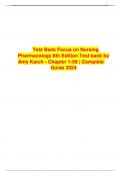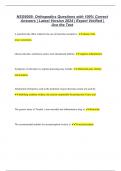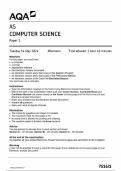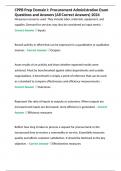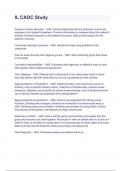1
Test Bank Focus on Nursing
Pharmacology 8th Edition Test bank by
Amy Karch - Chapter 1-59 | Complete
Guide 2024
, Chapter 01: Introduction to Drugs
A nurse working in radiology administers iodine to a patient who is having a computed
tomography(CT) scan. The nurse working on the oncology unit administers chemotherapy to patients who
have cancer. At the Public Health Department, a nurse administers a measles-mumps-rubella (MMR)
vaccine to a 14-month-old child as a routine immunization. Which branch of pharmacology best describes
the actions of all three nurses?
Pharmacoecono
mics
Pharmacotherapeutic
s Pharmacodynamics
Pharmacokinetics
Ans: B
Feedback:
Pharmacology is the study of the biologic effects of chemicals. Nurses are involved with clinical
pharmacology or pharmacotherapeutics, which is a branch of pharmacology that deals with the uses of drugs
to treat, prevent, and diagnose disease. The radiology nurse is administering a drug to help diagnose a disease.
The oncology nurse is administering a drug to help treat a disease.
Pharmacoeconomics includes any costs involved in drug therapy. Pharmacodynamics involves how a
drug affects the body and pharmacokinetics is how the body acts on the body.
A physician has ordered intramuscular (IM) injections of morphine, a narcotic, every 4 hours as
neededfor pain in a motor vehicle accident victim. The nurse is aware this drug has a high abuse potential.
Under what category would morphine be classified?
Sched
ule I
Schedule II
Schedule
III
Schedule
IV Ans: B
,Feedback:
Narcotics with a high abuse potential are classified as Schedule II drugs because of severe dependence
, liability. Schedule I drugs have high abuse potential and no accepted medical use. Schedule III drugs
have a lesser abuse potential than II and an accepted medical use. Schedule IV drugs have low abuse
potential and limited dependence liability.
When involved in phase III drug evaluation studies, what responsibilities would the nurse
have? Working with animals who are given experimental drugs
Choosing appropriate patients to be involved in the drug study
Monitoring and observing patients closely for adverse effects
Conducting research to determine effectiveness of the drugAns: C
Feedback:
Phase III studies involve use of a drug in a vast clinical population in which patients are asked to record
any symptoms they experience while taking the drugs. Nurses may be responsible for helping collect and
analyze the information to be shared with the Food and Drug Administration (FDA) but would not conduct
research independently because nurses do not prescribe medications. Use of animals in drug testing is done in
the preclinical trials. Select patients who are involved in phase II studies to participate in studies where the
participants have the disease the drug is intended to treat. These patients are monitored closely for drug action
and adverse effects. Phase I studies involve healthy human volunteers who are usually paid for their
participation. Nurses may observe for adverse effects and toxicity.
What concept is considered when generic drugs are substituted for brand name drugs?
Bioavailability
Critical
concentration
Distribution
Half-
life Ans: A
Feedback:
Bioavailability is the portion of a dose of a drug that reaches the systemic circulation and is available to
act on body cells. Binders used in a generic drug may not be the same as those used in the brand name drug.
Therefore, the way the body breaks down and uses the drug may differ, which may eliminate a generic drug
substitution. Critical concentration is the amount of a drug that is needed to cause a therapeutic effect and
should not differ between generic and brand name medications. Distribution is the phase of pharmacokinetics,
which involves the movement of a drug to the body’s tissues and is the
, same in generic and brand name drugs. A drug’s half-life is the time it takes for the amount of drug to
decrease to half the peak level, which should not change when substituting a generic medication.
A nurse is assessing the patient’s home medication use. After listening to the patient list current
medications, the nurse asks what priority question?
Do you take any generic medications?
Are any of these medications orphan drugs?
Are these medications safe to take during
pregnancy? Do you take any over-the-counter
medications?
Ans: D
Feedback:
It is important for the nurse to specifically question use of over-the-counter medications because patients
may not consider them important. The patient is unlikely to know the meaning of orphan drugs unless they too
are health care providers. Safety during pregnancy, use of a generic medication, or classification of orphan
drugs are things the patient would be unable to answer but could be found in reference books if the nurse
wishes to research them.
After completing a course on pharmacology for nurses, what will the nurse
know? Everything necessary for safe and effective medication administration
Current pharmacologic therapy; the nurse will not require ongoing education for 5
years. General drug information; the nurse can consult a drug guide for specific drug
information. The drug actions that are associated with each classification of
medicationAns: C
Feedback:
After completing a pharmacology course nurses will have general drug information needed for safe and
effective medication administration but will need to consult a drug guide for specific drug information
before administering any medication. Pharmacology is constantly changing, with new drugs entering the
market and new uses for existing drugs identified. Continuing education in pharmacology is essential to safe
practice. Nurses tend to become familiar with the medications they administer most often, but there will
always be a need to research new drugs and also those the nurse is not familiar with because no nurse knows
all medications.
, A nurse is instructing a pregnant patient concerning the potential risk to her fetus from a Pregnancy
Category B drug. What would the nurse inform the patient?
Adequate studies in pregnant women have demonstrated there is no risk to the fetus.
Animal studies have not demonstrated a risk to the fetus, but there have been no adequate studiesin
pregnant women.
Animal studies have shown an adverse effect on the fetus, but there are no adequate studies
inpregnant women.
There is evidence of human fetal risk, but the potential benefits from use of the drug may
beacceptable despite potential risks.
Ans: B
Feedback:
Category B indicates that animal studies have not demonstrated a risk to the fetus. However, there have
not been adequate studies in pregnant women to demonstrate risk to a fetus during the first trimester of
pregnancy and no evidence of risk in later trimesters. Category A indicates that adequate studies in pregnant
women have not demonstrated a risk to the fetus in the first trimester or in later trimesters.
Category C indicates that animal studies have shown an adverse effect on the fetus, but no adequate
studies in humans. Category D reveals evidence of human fetal risk, but the potential benefits from the use of
the drugs in pregnant women may outweigh potential risks.
Discharge planning for patients leaving the hospital should include instructions on the use of over-the-
counter (OTC) drugs. Which comment by the patient would demonstrate a good understanding of OTC
drugs?
OTC drugs are safe and do not cause adverse effects if taken properly.
OTC drugs have been around for years and have not been tested by the Food and Drug
Administration (FDA).
OTC drugs are different from any drugs available by prescription and cost
less. OTC drugs could cause serious harm if not taken according to directions.
Ans: D
Feedback:
It is important to follow package directions because OTCs are medications that can cause serious harm if
not taken properly. OTCs are drugs that have been determined to be safe when taken as directed; however, all
drugs can produce adverse effects even when taken properly. They may have originally been prescription
drugs that were tested by the FDA or they may have been grandfathered in when the
, FDA laws changed. OTC education should always be included as a part of the hospital discharge
instructions.
What would be the best source of drug information for a nurse?
Drug Facts and Comparisons
A nurse’s drug
guide A drug
package insert
The Physicians’ Drug Reference (PDR)Ans: B
Feedback:
A nurse’s drug guide provides nursing implications and patient teaching points that are most useful to
nurses in addition to need-to-know drug information in a very user friendly organizational style.Lippincott’s
Nursing Drug Guide (LNDG) has drug monographs organized alphabetically and includes nursing implications
and patient teaching points. Numerous other drug handbooks are also on the market and readily available for
nurses to use. Although other drug reference books such as Drug Facts and Comparisons, PDR, and drug
package inserts can all provide essential drug information, they will not contain nursing implications and
teaching points and can be more difficult to use than nurse’s drug guides.
The nurse is preparing to administer a medication from a multidose bottle. The label is torn and soiledbut
the name of the medication is still readable. What is the nurse’s priority action?
Discard the entire bottle and contents and obtain a new
bottle. Find the drug information and create a new label for the
bottle. Ask another nurse to verify the contents of the bottle.
Administer the medication if the name of the drug can be
clearlyread. Ans: A
Feedback:
When the drug label is soiled obscuring some information the safest action by the nurse is to discard the
bottle and contents because drug labels contain a great deal of important information, far more than just the
name of the drug. Concentration of the drug, expiration date, administration directions, and precautions may
be missing from the label and so put the patient at risk. Looking up drug information in a drug handbook or
consulting with another nurse will not supply the expiration date or concentration of medication. Be safe
and discard the bottle and its contents.
, What aspect of pharmacology does a nurse study? (Select all that
apply.) Chemical pharmacology
Molecular pharmacology
Impact of drugs on the body
The body’s response to a drug
Adverse and anticipated drug
effectsAns: C, D, E
Feedback:
Nurses study pharmacology from a pharmacotherapeutic level, which includes the effect of drugs on the
body, the body’s response to drugs, and both expected and unexpected drug effects. Chemical and molecular
pharmacology (Options A and B) are not included in nursing pharmacology courses.
The nurse, providing patient teaching about home medication use to an older adult, explains that
evenwhen drugs are taken properly they can produce negative or unexpected effects. What are these
negative or unexpected effects called?
Teratogenic
effects Toxic
effects Adverse
effects
Therapeutic
effects Ans: C
Feedback:
Negative or unexpected effects are known as adverse or side effects. Teratogenic effects are adverse
effects on the fetus and not a likely concern for an older adult. Toxic effects occur when medication is taken
in larger than recommended dosages caused by an increase in serum drug levels. Therapeutic effects are the
desired actions for which the medication is prescribed.
After administering a medication, for what would the nurse assess the patient?
, Drug
effects
Allergies
Pregnancy
Preexisting
conditions Ans:A
Feedback:
After the medication is administered, the nurse assesses the patient for drug affects, both therapeutic
and adverse. The nurse would assess the patient for allergies, preexisting conditions, and pregnancy before
administering a medication.
The nurse receives an order to administer an unfamiliar medication and obtains a nurse’s drug guide
published four years earlier. What is the nurse’s most prudent action?
Find a more recent reference
source. Use the guide if the drug is
listed.
Ask another nurse for drug information.
Verify the information in the guide with the
pharmacist. Ans: A
Feedback:
The nurse is responsible for all medications administered and must find a recent reference source to
ensure the information learned about the medication is correct and current. Using an older drug guide could
be dangerous because it would not contain the most up-to-date information. Asking another nurse or the
pharmacist does not guarantee accurate information will be obtained and could harm the patient if the
information is wrong.
What would the nurse provide when preparing a patient for discharge and home medication self-
administration?
Personal contact information to use if the patient has questions
, Thorough medication teaching about drugs and the drug regimen
Over-the-counter medications to use to treat potential adverse effects

